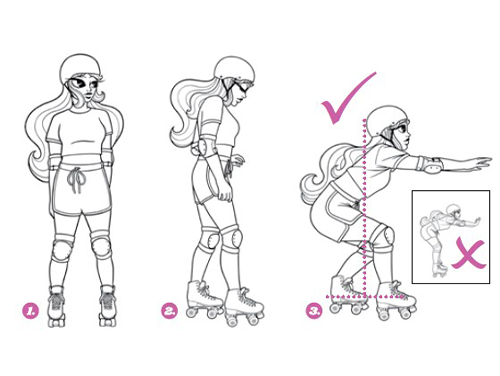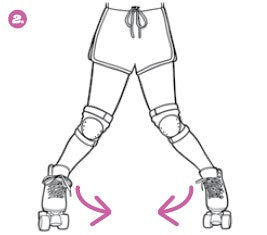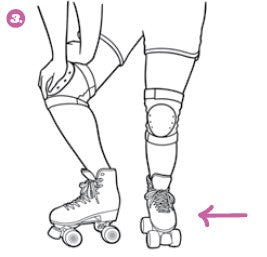Quads
Skating Guide
You just opened the box to your new Impala Roller Skates, first thing is to check over your skates - we recommend this before every use.
★ Check that all wheels are spinning smoothly.
★ Check your toe stops, wheels and trucks - if they are too loose, tighten them with the appropriate tool.
★ Fasten your laces and make sure your skates are not loose around your foot. If you notice movement of your feet in the skates, you should adjust the laces.
★ Always wear protective gear; a helmet, wrist guards, elbow guards and knee guards. We sell protective gear in an assortment of colors.
★ We recommend taking lessons to learn the basics of skating, or seeking advice from an experienced skater when you are getting started.
★ Always observe road rules and avoid high-traffic areas.
★ We recommend that children skate under adult supervision at all times.
2. How to correctly tie your laces
Securing your laces correctly will keep you safe while skating.
Scroll to view more steps >>
The higher you lace your eyelets, the more stiff the boot will be around your ankle - which is great for beginners as it provides maximum support and stability. As you progress at skating you may want to tie up to the first eyelet only (as shown above) for more freedom of movement.
Scroll to view more steps >>
How to Stop:
Plow Stop
There are a number of ways you can stop on roller skates. We will show you two ways, we recommend learning them both.
Difficulty: ★★☆☆☆
Scroll to view more steps >>
T-Stop
There are a number of ways you can stop on roller skates. We will show you two ways, we recommend learning them both.
Difficulty: ★★★☆☆
Scroll to view more steps >>
Using Toe-Stops and Falling Safely
-

Using Toe-Stops
Only use toe-stops to stop when you are skating backwards. Using toe stops while skating forwards can be dangerous.
-
Always look where you are going.
-
1. Look over your shoulder as you skate backwards.
2. Ensure you are skating in a staggered stance.
3. Lift your heels.
4. Press your weight on to your stoppers, as pictured above.
-
TIP: Toe-stops can also be used for stabilizing yourself while standing still, for
walking up/down stairs safely, and for when you don’t want to skate down a hill. -

Practice Falling Safely heel in.
Falling is a part of the process. It’s important to learn how to fall safely.
-
★ Learning to skate takes time and practice, and falling is not a sign of failure.
★ Even the best skaters fall, do not discount your progress because of this.
★ When you feel unsteady - crouch down, lean forward and slide on your
safety gear.★ Keep your fingers facing up to avoid grazing them as you fall.
★ Remember to always wear your protective gear!
FAQ
★ Loosen and remove the axle nut using a Skate tool, socket wrench, or nut driver.
★ Remove wheel from axle.
★ Repeat for all four heels on each skate.
★ Put axle nuts, wheels and hardware aside.
★ Replace the wheel and axle nut, then tighten securely.
★ Check that all wheels are still spinning smoothly. Adjust if required.
★ Do not tighten your wheels too far - this can damage the bearings and hinder smooth skating.
★ Our skates come with the trucks ‘tight’ as standard, which is great for when you are learning to skate. Tighter = more stability, looser = more maneuverability.
★ To loosen or tighten your trucks, use a Skate tool to adjust the tightness of the kingpin nut on both trucks.
★ Loosening the trucks will give you more mobility but remember more mobility means less stability, so be careful!
★ Ensure that all hardware is lined up and sitting ‘flush’ - bushings, washer cap, pivot cup. Sometimes they can move when you make adjustments.
★ Listen to your skates - if they rattle, the hardware may need to be adjusted.
If your wheels and bearings aren’t spinning freely, you may need to clean them. For cleaning the wheels, you will need a cleaning cloth. For bearings, you will need lubricant. Cleaning the wheels and bearings will ensure longevity of your skates.
★ Remove all wheels using a Skate tool and the axles from the roller skate.
★ Wipe off the dirt from the wheels.
★ Clean off axles.
★ Clean the baseplate with a cloth.
★ You can remove the bearings by prying them out of your wheels using the axle on your truck. Use a safety pin to remove the rubber covers (or ‘shields’) from the bearings.
★ Wipe away grime. Avoid using water, this can cause the bearings to rust.
★ Apply two drops of lubricant to each bearing and put the shields back on.
★ Be sure to put spacer back between bearings before putting the wheels back on.
★ Install and tighten your axle nuts using a Skate tool, socket wrench, or nut driver.
WARNING:
★ Always replace stoppers once they have worn down.
★ If you decide to skate without stoppers, you do so at your own risk.
★ We strongly suggest that you do not make any changes or modifications which could impair the essential features of your Impala Roller Skates, as this could affect the safety of the product and user.
★ Keep this manual to refer back to in the future.
★ Wheels: If you notice any cracks, delamination or excessive wear and tear, please replace wheels. The poor state of wheels may impair their effectiveness and your ability to control your quad skates.
★ Always check for any sharp edges caused by use or maintenance, sharp edges may be removed with a file.

 Australia
Australia
 United States
United States




























